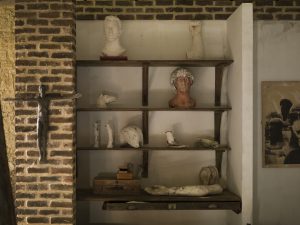by Hope Francis, researcher
When Frink first went to Guildford art school she carved in wood and had attempted stone. However, she found these methods of sculpting slow and inflexible for what she wanted to achieve. She also tried to clay modelling but also found this process slow.
It is not exactly known how she decided on using plaster, however she may have heard that Giocometti used it in his creative process. At the Chelsea School of Art, her mentor Bearnard Meadows taught in it and Henry Moore ( a regular visitor to the school) also used it, which may have prompted the decision.
 For Frink, the ideal material was Plaster of Paris which came as a fine powder and set within minutes. It matched the speed at which she created. It also got rid of the lengthy processes involved in other modes of sculpting. With plaster, she could model and carve. When talking about plaster Frink said “ The process is totally flexible that’s one of the marvellous things about working in plaster.” She also said that she got her ideas very quickly and using plaster mirrored that pace.
For Frink, the ideal material was Plaster of Paris which came as a fine powder and set within minutes. It matched the speed at which she created. It also got rid of the lengthy processes involved in other modes of sculpting. With plaster, she could model and carve. When talking about plaster Frink said “ The process is totally flexible that’s one of the marvellous things about working in plaster.” She also said that she got her ideas very quickly and using plaster mirrored that pace.
Once it is set you have a completely rigid thing to work on and take to the next stage and it is not like clay which is always falling apart and dripping”. When addressing why she didn’t use clay she said that “ I hate using clay apart from everything else it weighs a tone”. She would carve back right from the beginning of forming the piece. Frink said that it “was a constant process of rebuilding and adjusting, of carving back until I have what I want”.
Frink’s method involved building up layers of plaster on top of chicken wire. Her plaster was often soaked in hessian which gave a good surface to build up from. She then would give further texture to the plaster by mixing up materials such as sawdust, making it appear grittier in texture.
Image (top): The Frink Studio at Messums West in 2019
